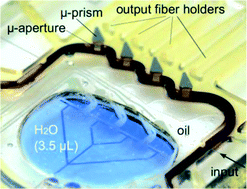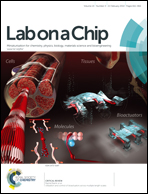Optofluidic router based on tunable liquid–liquid mirrors†
Abstract
We present an electrically tunable 1 × 5 optofluidic router for on-chip light routing. The device can redirect light from an optical input channel into five output channels by exploiting total internal reflection (TIR) at a liquid–liquid interface. The liquid–liquid mirrors, demonstrated for the first time, are tuned using integrated electrowetting-on-dielectrics (EWOD) actuators. The router is assembled from two chips fabricated by standard MEMS techniques. Through a combination of microfluidic with micro-optical components on chip, reliable light routing is achieved with switching times of [1.5–3.3] s, efficiencies of coupling into channels of up to 12%, optical cross-talk as low as −24 dB, a required drive voltage of 50 V, and a low power consumption of <5 mW, using a device 12 × 13 × 2 mm3 in size. The optofluidic approach enables addressing of multiple channels over a broad wavelength range. Such optical routing capabilities are important for lab-on-chip devices focusing on optical spectroscopy, optical detection, or even optical manipulation. When integrated with external light sources and a low-cost disposable photonic lab-on-a-chip, the router could thus lead to novel laboratory measurement systems.

- This article is part of the themed collection: Optofluidics-2013

 Please wait while we load your content...
Please wait while we load your content...